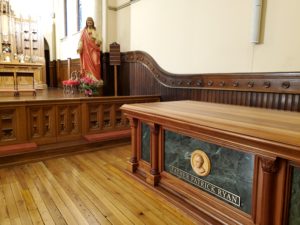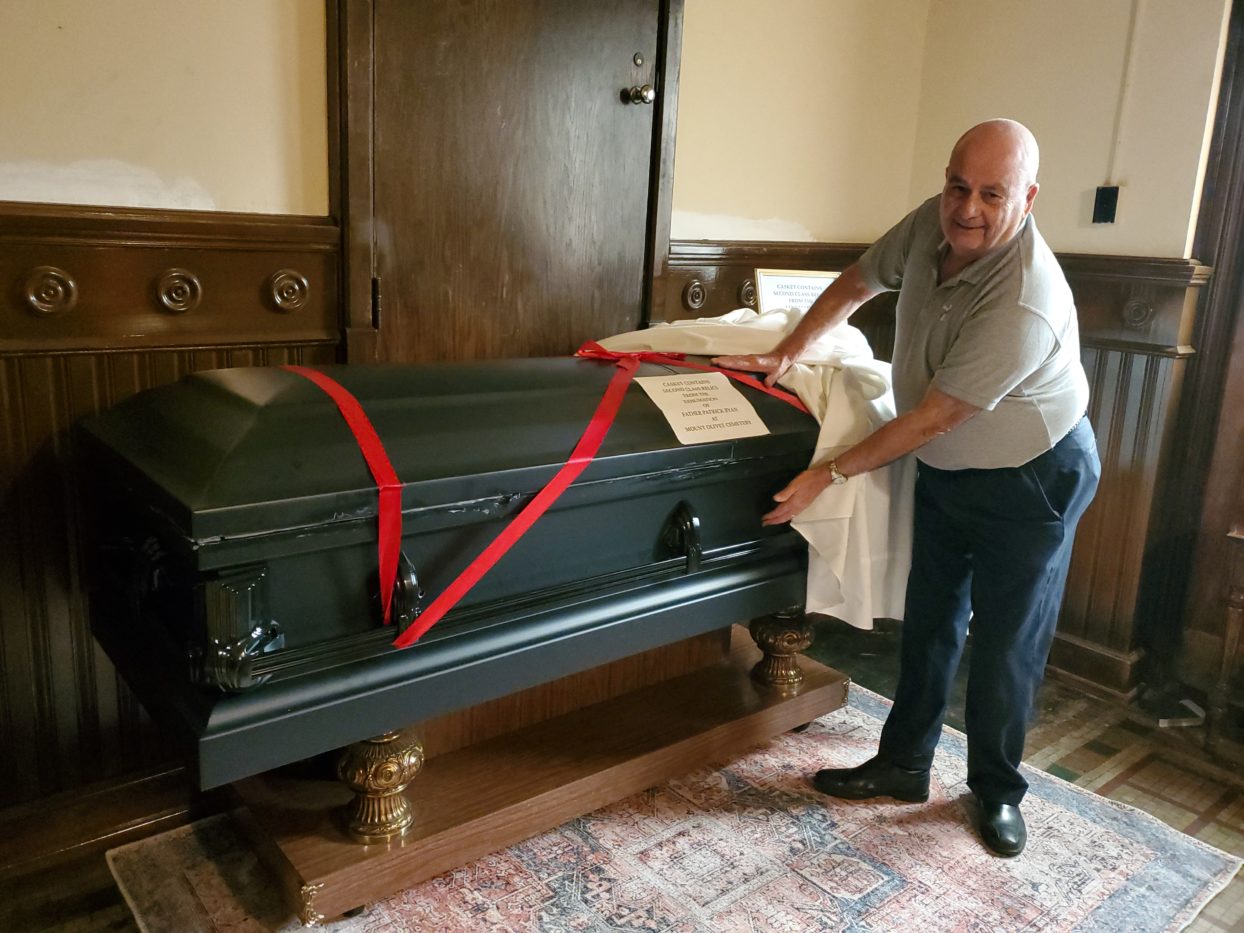Possible second-class relics from Servant of God’s remains occupy a casket in anticipation of canonization
By Gabrielle Nolan
In the Church, relics are an important component of the Catholic faith, commemorating the saints who have gone before who are able to intercede in the lives of the faithful through their prayers and holy examples.
For many of the faithful in the Diocese of Knoxville, it is their hope that Servant of God Father Patrick Ryan will someday join the list of canonized saints and that his belongings officially become relics.
“The Servant of God is the first step, and the bishop has declared him Servant of God back… when we started the cause in 2016,” said Deacon Gaspar DeGaetano, who serves at the Basilica of Sts. Peter and Paul in Chattanooga and who also serves as the diocesan postulator in the sainthood cause for Father Ryan.
“In the Catholic Church, we make distinctions between the things that remain of a saint,” explained Father David Carter, rector of the basilica.

The remains of Father Patrick Ryan are now entombed in the nave of the Basilica of Sts. Peter and Paul in Chattanooga. Behind the statue of the Sacred Heart of Jesus, next to the altar, is the basilica reliquary.
“Father Patrick Ryan is not there yet. We’re still in the process of postulating his sanctity, asking Rome and the Holy See, the Pope, to declare him saint one day. That’s going to require miracles and things like that,” Father Carter noted.
According to the basilica rector, the garments and possessions of Father Ryan will not be venerated as relics until after his prayed-for canonization. If and when the items are displayed in the basilica, they will be referred to as “historical artifacts of significance to Father Ryan.”
Father Ryan, once pastor of the downtown Chattanooga parish, died in 1878 of yellow fever after ministering to patients in Chattanooga during the epidemic.
Father Carter noted that after Father Ryan’s death, locals recognized him as a hero, and Knights of Columbus councils were eventually named after him.
“Even though he’s not a canonized saint, he’s still hailed as a hero, and he’s an exemplar cause of priesthood in our day, that the priesthood is under attack,” Father Carter said. “So if we want a good example of who a priest is and should be, well, there’s Father Patrick Ryan.”
The Church makes distinctions between first-, second-, and third-class relics.
First-class relics are the actual mortal remains, such as the bones, of the human saint.
Father Ryan’s remains were verified in July when a successful exhumation of his grave at Mount Olivet Cemetery in Chattanooga revealed priestly vestments alongside a full skeleton. His bones were then placed in a new casket for his re-entombment at the basilica on July 31.
“But then all of the other accoutrement of a person, you know, one’s possessions, the things that they were wearing, the things buried with them that had meaning for that person, those are considered what we call second-class relics,” Father Carter explained.
Such items of Father Ryan’s that survived to today include his clothing, vestments, scapular, crucifix, and travel stole.
“He’s known from having gone from house to house during the yellow fever epidemic, and it’s very probable, to the point of likely, that that stole that they buried him with — why would they have done that? That that’s the stole that he used in ministering to the people that caused him to be the hero, you know, that caused people to say this man lived like Christ,” Father Carter said.
Originally, the team exhuming the coffin had concerns about exposure to arsenic, which in that era was commonly used for embalming. A fear that arsenic had contaminated all of the contents of the coffin led to the question of whether the items could be kept.
“All of these things, very well preserved, and those were the things that we secondarily took the time to have pulled out of the coffin, preserved or at least purified because we thought that there was arsenic, but there’s not arsenic. We got the tests, thanks be to God,” Father Carter said.
“They were cleaned in simple, pure water… so that it would cleanse the contaminants, because that’s what we were concerned with. We weren’t necessarily cleansing them for preservation, we were cleansing them of contaminants,” he said.
Even though water had leaked into the original cast iron coffin, the “vestments were in excellent condition,” said Deacon DeGaetano.
A mausoleum at the cemetery was used to allow the vestments to air dry completely.
“We used these screens that came from my attic in my house that fit right in between the two walls of the mausoleum, it was amazing,” Deacon DeGaetano said. “So that’s where we had the vestments drying out for about two to three weeks.”
Once dried, the garments were then individually vacuumed-sealed in bags for preservation.
Getting the vestments and other items from Father Ryan’s grave to their current location in the basilica wasn’t easy given the environmental concerns that surfaced.

The casket containing possessions that Father Patrick Ryan was buried with is protected under seal inside the Basilica of Sts. Peter and Paul.
On July 27, the second day of the exhumation, a medical doctor on site suspected the possible presence of arsenic inside the coffin. Arsenic is a toxic heavy metal and was often used to embalm bodies in the 19th century, before the hazards of using it were understood. Diocesan Chancellor Deacon Sean Smith immediately contacted state environmental officials and reached out to EnSafe, a Memphis-based environmental engineering, health and safety, and technology company he had previously worked for in its Knoxville office.
EnSafe professionals Mike Palmer, Deb Halcrow, and Jennifer Mayfield arrived at Mount Olivet Cemetery from Knoxville on Wednesday morning, July 28, and under extremely difficult conditions, with temperatures at or above 100 degrees, donned protective suits and spent all day cleaning artifacts, including the remains of Father Ryan.
They were joined that evening by EnSafe staff members Ian Davis, David Brown, and Kellen Finn to complete the arduous task.
Later that night, after more than 12 hours of work, all the historic artifacts were cleaned and placed in the coffin designated for their repose.
That detailed cleaning was vital for the preservation of the possible second- and third-class relics from Father Ryan.
Third-class relics are items that have touched or are touched to either a first- or second-class relic.
“That even touching the things that touched the holy things is a transfer of spiritual goodness, right, a connection with this holy person whose body will participate in the resurrection of the just on the last day,” Father Carter said. “We know that because they’re canonized saints. Now, again, we’re not talking specifically about Father Patrick Ryan, because he’s not been declared as such, but we hope he will be, and we’re getting ready for the day when he will be, so that we can say, well, we got the relics.”
Holy cards for Father Ryan are available in the entryway of the basilica, containing a small piece of cloth adhered to the card.
“I made new third-class relics before we closed up his new coffin, after he was vested. I laid sheets in there and then those have been chopped up,” Deacon DeGaetano said.
The new casket, provided by Chattanooga Funeral Home, contains the original coffin Father Ryan was buried in, as well as his individually sealed garments.
“Chattanooga Funeral Home… gave us a lot of assistance and transportation and also gave us this casket and then the one that’s in the tomb up front with his remains,” Deacon DeGaetano said.
Red ribbons wrap around the casket, with a seal from the bishop imprinted on the top to indicate the contents are true and have not been tampered with, in accordance with canon law.
As the sainthood process for Father Ryan continues, there are plans on how to honor and showcase the someday-saint in the basilica room where the casket and garments reside.
“We’ll probably make that into a historical display, a room where you can go in and see these second-class relics. We wouldn’t necessarily call them that, at this point, but that’s what they will eventually be,” Father Carter explained.
“We could tell the story of his life and put pictures and timelines and display these things. That would be eventually what we want to do with that,” he added.
“His presence in the Church has definitely been to the benefit of the faithful of Chattanooga, the inspiration of faith amongst the people of Chattanooga, and our parish in particular, and to really hold up that, yes, God is still at work, and God is still raising people up to follow him and to allow grace to transform them into holy and good things,” Father Carter said.
Until the vestments are displayed, the faithful are welcome to visit and pray in front of Father Ryan’s tomb, located in the front of the nave on the right side, directly below the Fourteenth Station of the Cross: Jesus is laid in the tomb.
“That was his last wish—bury me among my people, was his dying wish. So now we’ve kind of brought him back and entombed him there,” Father Carter said. “This priest who had exemplified, in a heroic way, closeness to his people, even to the point of sharing their illness and death, that he can now be close to us in this place.”

